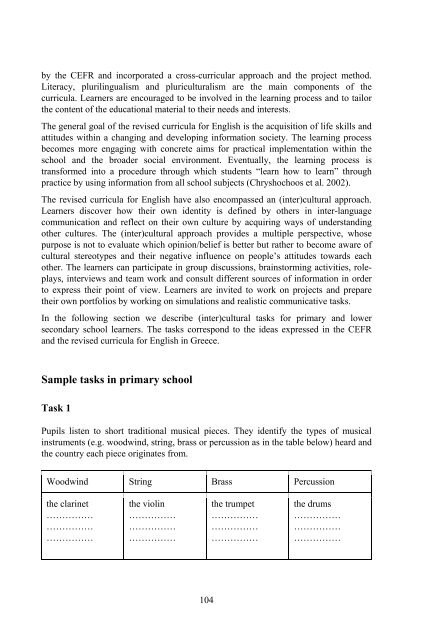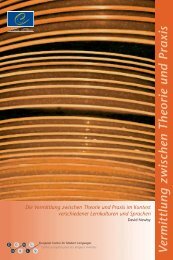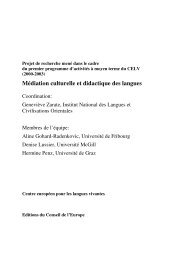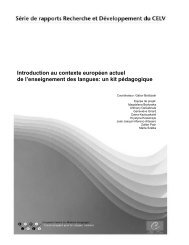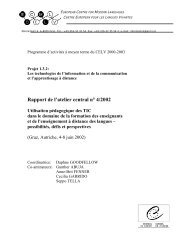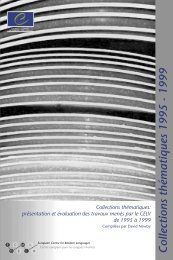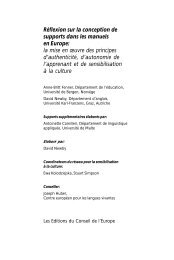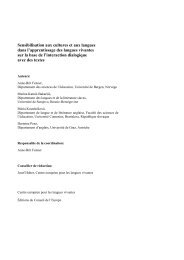cohesion - European Centre for Modern Languages
cohesion - European Centre for Modern Languages
cohesion - European Centre for Modern Languages
Create successful ePaper yourself
Turn your PDF publications into a flip-book with our unique Google optimized e-Paper software.
y the CEFR and incorporated a cross-curricular approach and the project method.<br />
Literacy, plurilingualism and pluriculturalism are the main components of the<br />
curricula. Learners are encouraged to be involved in the learning process and to tailor<br />
the content of the educational material to their needs and interests.<br />
The general goal of the revised curricula <strong>for</strong> English is the acquisition of life skills and<br />
attitudes within a changing and developing in<strong>for</strong>mation society. The learning process<br />
becomes more engaging with concrete aims <strong>for</strong> practical implementation within the<br />
school and the broader social environment. Eventually, the learning process is<br />
trans<strong>for</strong>med into a procedure through which students “learn how to learn” through<br />
practice by using in<strong>for</strong>mation from all school subjects (Chryshochoos et al. 2002).<br />
The revised curricula <strong>for</strong> English have also encompassed an (inter)cultural approach.<br />
Learners discover how their own identity is defined by others in inter-language<br />
communication and reflect on their own culture by acquiring ways of understanding<br />
other cultures. The (inter)cultural approach provides a multiple perspective, whose<br />
purpose is not to evaluate which opinion/belief is better but rather to become aware of<br />
cultural stereotypes and their negative influence on people’s attitudes towards each<br />
other. The learners can participate in group discussions, brainstorming activities, roleplays,<br />
interviews and team work and consult different sources of in<strong>for</strong>mation in order<br />
to express their point of view. Learners are invited to work on projects and prepare<br />
their own portfolios by working on simulations and realistic communicative tasks.<br />
In the following section we describe (inter)cultural tasks <strong>for</strong> primary and lower<br />
secondary school learners. The tasks correspond to the ideas expressed in the CEFR<br />
and the revised curricula <strong>for</strong> English in Greece.<br />
Sample tasks in primary school<br />
Task 1<br />
Pupils listen to short traditional musical pieces. They identify the types of musical<br />
instruments (e.g. woodwind, string, brass or percussion as in the table below) heard and<br />
the country each piece originates from.<br />
Woodwind String Brass Percussion<br />
the clarinet<br />
……………<br />
……………<br />
……………<br />
the violin<br />
……………<br />
……………<br />
……………<br />
104<br />
the trumpet<br />
……………<br />
……………<br />
……………<br />
the drums<br />
……………<br />
……………<br />
……………


